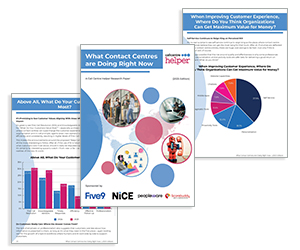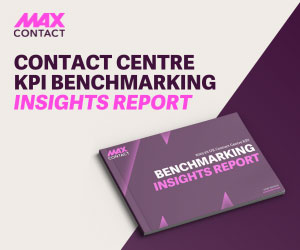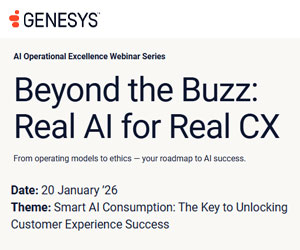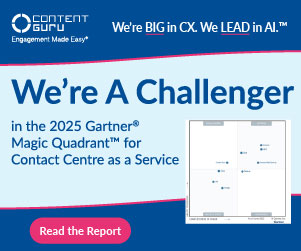Liran Meir Frenkel at NiCE explores how proactive customer engagement, powered by data, AI, and automation, drives revenue, strengthens brand loyalty, and creates real-world business impact.
In today’s hyper-connected, always-on world, customer experience no longer begins when a person dials your number or clicks your website – it starts long before.
The most impactful brands don’t just respond to customer needs – they anticipate them. They reach out before issues arise, offer help before questions are asked, and guide customers before confusion sets in. This shift to create a proactive world, where engagement is always a step ahead, is the new standard.
We’re entering an era of proactive engagement, where businesses build deeper relationships by staying one step ahead – using real-time data, AI, and automation to connect with customers in smarter, faster, more meaningful ways. In this world, engagement isn’t reactive – it’s strategic. It’s not about waiting; it’s about leading the experience.
Now, lets go a level deeper – unpacking the real-world business impact and why proactive engagement is no longer a nice-to-have, but a must-have. Because when engagement is always a step ahead, outcomes aren’t just better – they’re transformational.
Shifting the Paradigm: From Support to Smart Engagement
Proactive engagement isn’t just a tactic – it’s a new model for customer relationships. It enables organizations to automate with purpose, connect without boundaries, and understand deeply.
This paradigm forms the foundation of a smarter, more human customer experience – one where technology anticipates needs, and every conversation creates value. People today want what they want, and they want it now – or, more precisely, they want it yesterday.
From Amazon telling you what you’d like to order with the correct size and colour suggestions, to Google searches predicting the remainder of your question before it’s been typed out, and GPS automatically re-routing on your behalf… it’s what we’ve all come to expect.
And in the competitive business landscape, where driving revenue and building brand loyalty are top priorities for companies coupled with the constant need to do much more with much less, one powerful strategy to achieve these goals is proactive customer engagement that keeps up with this pace.
Proactive customer engagement involves reaching out to customers before they encounter problems or before they make a request, rather than waiting for them to contact support or raise concerns. Examples include:
- Sending tips based on customer behavior
- Offering personalized recommendations
- Notifying customers about potential service issues in advance
- Following up after an interaction with helpful content or opportunities
Recent research from Metrigy reinforces this shift from the consumer’s perspective. In a survey of over 500 North American consumers, 69% said they want companies to proactively reach out, but only when the outreach provides clear value.
The top reasons include preventing a problem, saving money or time, and receiving helpful, personalized information.
This data shows that proactive outreach isn’t about more communication- it’s about the right kind of communication. Customers are busy. They want interactions that save them hassle or offer something tangible and valuable in return.
By reaching out before customers even realize they need help, businesses turn everyday interactions into powerful moments of connection, trust, and impact.
As Shep Hyken puts it, “A moment of magic happens when you deliver a better-than-expected customer experience” – and proactive engagement sets the stage for those moments every time.
Why Proactive Engagement Matters: 3 Pillars of Business Impact
Proactive customer engagement is more than a CX trend, it’s a business strategy with far-reaching impact. When done right, it transforms the customer journey from reactive support to a continuous value exchange.
By reaching out before customers even ask, brands not only solve problems faster – they unlock three powerful outcomes that drive business success:
Here are three compelling cases for proactive customer engagement in your business:
1. Rise in Revenue
Proactive customer engagement has a significant impact on a company’s financial performance. It helps address issues early and keeps customers satisfied. And engaged customers are more likely to buy more, upgrade, renew – and stick around.
This is where organizations can automate with purpose-using AI and real-time data to ensure outreach happens at the right time, through the right channel, and with the right message. That kind of intelligent orchestration leads to measurable results.
According to Aberdeen’s research from December 2024, companies that employ proactive engagement strategies report substantial improvements in key revenue metrics.
For instance, these companies have seen a 9.4% increase in annual company revenue, an 8.6% rise in customer lifetime value, and a 6.4% boost in cross-sell and up-sell revenue.
Clearly, proactive engagement means serious financial benefits, making it a valuable strategy for driving revenue growth. The bigger numbers speak for themselves.
2. Brand Benefit
Beyond just financial benefits, proactive engagement also enhances brand equity.
It fosters customer trust and loyalty because anticipating needs shows that a brand truly cares. When companies proactively engage, they demonstrate a commitment to being present, consistent, and forward-thinking.
In this way, they connect without boundaries – creating continuity across channels, experiences, and interactions.
The proactive support builds a reputation for reliability and excellence, and the reality is that customers are more likely to stick with a brand that feels attentive and responsive.
Happy customers give positive referrals and share their experiences with others – far more powerful (and less expensive) than any paid campaign.
At the end of the day, proactive engagement helps you stand out in a crowded market. Companies that proactively engage with their customers report a 10.6% increase in positive social media mentions and a 7.2% improvement in the number of quality Service Level Agreements met. If they love you, they’ll keep you.
3. Real-Life Impact
So, how does proactive customer engagement make an impact in real-life?
Take the case of a multinational fintech company. Previously, their outreach was mostly reactive and manual, leading to inefficiencies and missed opportunities.
But they underwent a transformation – turning fragmented customer touchpoints into a unified, intelligent outreach strategy.
According to recent research by Robin Gareiss of Metrigy, about 60% of companies proactively reach out to customers, with or without the use of AI and automation.
While 59% still rely on manual outreach and 48% use non-AI rules-based automation, 47% have already adopted AI-powered methods for dynamic, automated engagement.
The business results are clear:
- 82% report improved CSAT
- 65% see gains in agent efficiency
- 61% generate more revenue
- 50% experience cost reduction
These findings underscore the importance of not just being proactive – but doing it in a smart, automated, and timely way. And that requires contextual data, AI, and the right orchestration.
This blog post has been re-published by kind permission of NiCE-ltd – View the Original Article
For more information about NiCE-ltd - visit the NiCE-ltd Website
Call Centre Helper is not responsible for the content of these guest blog posts. The opinions expressed in this article are those of the author, and do not necessarily reflect those of Call Centre Helper.
Author: NiCE-ltd
Reviewed by: Rachael Trickey
Published On: 3rd Sep 2025
Read more about - Guest Blogs, NiCE, NiCE CXone






 NiCE (NASDAQ: NICE) is transforming the world with AI that puts people first. Our purpose-built AI-powered platforms automate engagements into proactive, safe, intelligent actions, empowering individuals and organizations to innovate and act, from interaction to resolution. Trusted by organizations throughout 150+ countries worldwide, NiCE’s platforms are widely adopted across industries connecting people, systems, and workflows to work smarter at scale, elevating performance across the organization, delivering proven measurable outcomes.
NiCE (NASDAQ: NICE) is transforming the world with AI that puts people first. Our purpose-built AI-powered platforms automate engagements into proactive, safe, intelligent actions, empowering individuals and organizations to innovate and act, from interaction to resolution. Trusted by organizations throughout 150+ countries worldwide, NiCE’s platforms are widely adopted across industries connecting people, systems, and workflows to work smarter at scale, elevating performance across the organization, delivering proven measurable outcomes. 





























